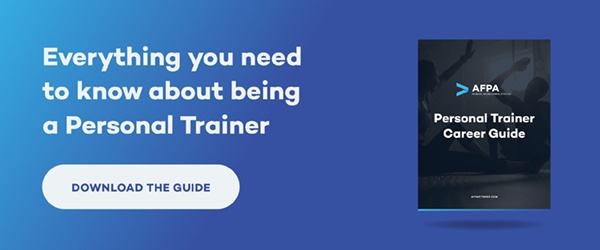Everybody starts somewhere. After you’ve done all the work to earn your personal training certification, you have the knowledge and skills to help people lose weight, build muscle, train for a race, or get in shape. But before you can put your skills to work, you need to find your first client.
As a personal trainer, sales and marketing are part of your job. It’s how you get clients. And you’ll probably have to do more of it in the beginning to get fully booked. Once you’ve helped just a few clients get results, they’ll likely send referrals your way. Until then, how do you find your first personal training client?
Here are five ways to connect with potential clients, generate interest, and book your first session:
1. Work Out
Start by looking the part. Work out, eat healthy, and train smart to develop your body. When you’re in the gym working out, put in your best effort, use perfect technique and a range of exercises. Smile and be confident and friendly. You may not realize it at first, but people will take notice. When you’re that guy or girl with a great physique who knows how to lift and get results, you’ll naturally attract people who will ask you for advice about exercise, training strategies, nutrition guidelines, and training programs. Be helpful and let them know you’re also a personal trainer.
2. Make a Suggestion
Ever seen someone confused about how to use a piece of gym equipment? Or worse, perform an exercise like a barbell squat or deadlift with bad form that could lead to an injury? It happens. And there are millions of jaw-dropping gym-fail videos to prove it. The next time you see someone struggling with an exercise or using bad form, recognize it as an opportunity. Ask the person, “May I make a suggestion?”
Chances are pretty good he or she will be willing to listen. Then show him or her how to adjust his or her form and use proper technique to perform the exercise safely and correctly. Keep it brief. The person will likely ask you how you know so much about training or may tell his or her friends about the person at the gym who gave him or her some helpful pointers.
3. Offer Free Assessments
Here’s another great way to get your first client. Offer free assessments. You don’t need to drop a bunch of money on advertising to do this. Just let people know you’re a personal trainer and offer free, no-obligation fitness assessments (e.g., body composition, overhead squat assessment, Rockport Walk Test, sit-up test, push-up test, step test). Take a prospect through a couple of these assessments. Then explain the results and what actions he or she can take to improve.
You can do a couple of these assessments and discuss the results in 30 minutes or less. That’s it. It’s a great way to help people get to know, like, and trust you as a personal trainer and land your first client.
4. Tap Into Your Network
When you’re starting your personal training business, tapping into your network is a great way to land your first personal training client. Just let the people in your network know you’re looking for personal training clients who need help with losing weight or building muscle, for example. You can do this by word of mouth, email, or by sending a letter. You could also consider training an influencer in your network for free, in exchange for word-of-mouth referrals.
5. Use Social Media
Choose at least one social media platform (Facebook, Twitter, Instagram, Snapchat, etc.) to share information about health and fitness. Post short videos of your workouts. Share tips and information about things like injury prevention, proper form, nutrition, motivation, and training strategies. Comment on posts other people make. When you meet someone new, “like” or “follow” him or her on social media. You’ll make connections, and people will ask you for advice. It’s a great way to stand out as a personal trainer and land your first client.
Landing your first personal training client doesn’t have to be hard. Look the part. Help others out when you’re in the gym. Offer free fitness assessments. Ask your network for referrals. And use social media. These are five highly effective marketing strategies that will help you attract prospects and book your first personal training session.




